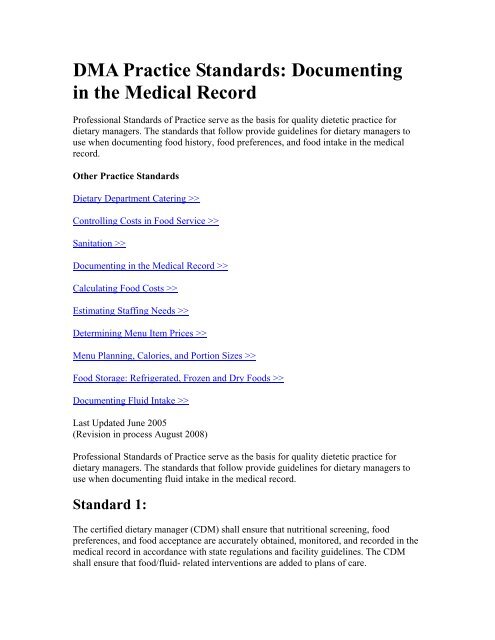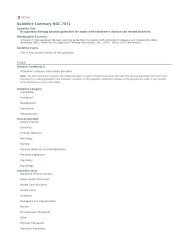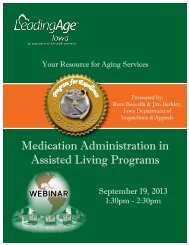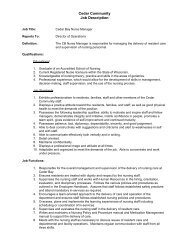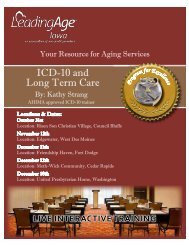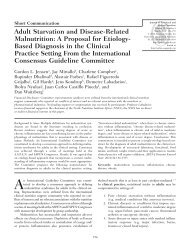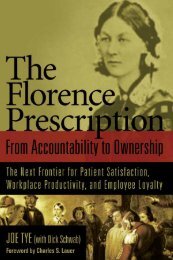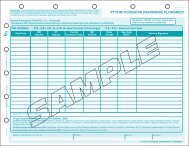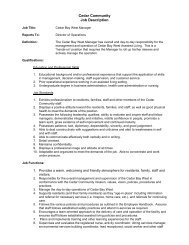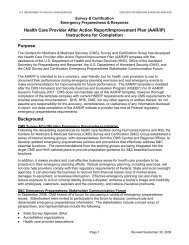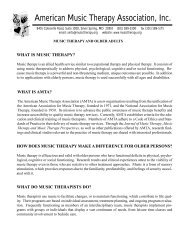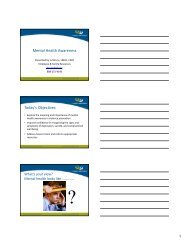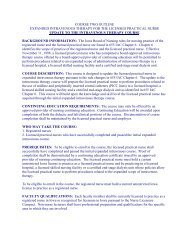DMA Practice Standards: Documenting in the Medical Record - Iowa ...
DMA Practice Standards: Documenting in the Medical Record - Iowa ...
DMA Practice Standards: Documenting in the Medical Record - Iowa ...
Create successful ePaper yourself
Turn your PDF publications into a flip-book with our unique Google optimized e-Paper software.
<strong>DMA</strong> <strong>Practice</strong> <strong>Standards</strong>: <strong>Document<strong>in</strong>g</strong><strong>in</strong> <strong>the</strong> <strong>Medical</strong> <strong>Record</strong>Professional <strong>Standards</strong> of <strong>Practice</strong> serve as <strong>the</strong> basis for quality dietetic practice fordietary managers. The standards that follow provide guidel<strong>in</strong>es for dietary managers touse when document<strong>in</strong>g food history, food preferences, and food <strong>in</strong>take <strong>in</strong> <strong>the</strong> medicalrecord.O<strong>the</strong>r <strong>Practice</strong> <strong>Standards</strong>Dietary Department Cater<strong>in</strong>g >>Controll<strong>in</strong>g Costs <strong>in</strong> Food Service >>Sanitation >><strong>Document<strong>in</strong>g</strong> <strong>in</strong> <strong>the</strong> <strong>Medical</strong> <strong>Record</strong> >>Calculat<strong>in</strong>g Food Costs >>Estimat<strong>in</strong>g Staff<strong>in</strong>g Needs >>Determ<strong>in</strong><strong>in</strong>g Menu Item Prices >>Menu Plann<strong>in</strong>g, Calories, and Portion Sizes >>Food Storage: Refrigerated, Frozen and Dry Foods >><strong>Document<strong>in</strong>g</strong> Fluid Intake >>Last Updated June 2005(Revision <strong>in</strong> process August 2008)Professional <strong>Standards</strong> of <strong>Practice</strong> serve as <strong>the</strong> basis for quality dietetic practice fordietary managers. The standards that follow provide guidel<strong>in</strong>es for dietary managers touse when document<strong>in</strong>g fluid <strong>in</strong>take <strong>in</strong> <strong>the</strong> medical record.Standard 1:The certified dietary manager (CDM) shall ensure that nutritional screen<strong>in</strong>g, foodpreferences, and food acceptance are accurately obta<strong>in</strong>ed, monitored, and recorded <strong>in</strong> <strong>the</strong>medical record <strong>in</strong> accordance with state regulations and facility guidel<strong>in</strong>es. The CDMshall ensure that food/fluid- related <strong>in</strong>terventions are added to plans of care.
Criteria1.1 Nutritional screen<strong>in</strong>gs are obta<strong>in</strong>ed from clients <strong>in</strong> a timely manner that comply withregulatory agency guidel<strong>in</strong>es.1.2 Managers use standardized forms for record<strong>in</strong>g nutritional screen<strong>in</strong>g.1.3 Qualified dietary staff will receive tra<strong>in</strong><strong>in</strong>g to obta<strong>in</strong> nutritional screen<strong>in</strong>g<strong>in</strong>formation.1.4 Food preferences/nutritional screen<strong>in</strong>g/fluid <strong>in</strong>take will be entered <strong>in</strong>to <strong>the</strong> medicalrecord by qualified staff accord<strong>in</strong>g to state regulations.1.5 All medical records are legal documents; entries <strong>in</strong> <strong>the</strong> medical record will be <strong>in</strong> black<strong>in</strong>k, dated, signed with full name and title, and never backdated or erased. Chart errorsare corrected by a one-l<strong>in</strong>e strike out, <strong>in</strong>itialed, dated, and labeled “error.”1.6 In cases where facilities have an <strong>in</strong>dividual’s record ma<strong>in</strong>ta<strong>in</strong>ed by computer, ra<strong>the</strong>rthan hardcopy, electronic signatures are acceptable. Follow<strong>in</strong>g are guidel<strong>in</strong>es for acomputerized record system:1.6.1 There is a written policy, at <strong>the</strong> healthcare facility, describ<strong>in</strong>g <strong>the</strong> attestation policy<strong>in</strong> force at <strong>the</strong> facility.1.6.2 The computer has built-<strong>in</strong> safeguards to m<strong>in</strong>imize <strong>the</strong> possibility of fraud.1.6.3 Each person responsible for an attestation has an <strong>in</strong>dividual identifier.1.6.4 The date and time is recorded from <strong>the</strong> computer’s <strong>in</strong>ternal clock at <strong>the</strong> time ofentry. An entry is not to be changed after it has been recorded.1.6.5 The computer program controls what actions/areas any <strong>in</strong>dividual can access orenter data, based on <strong>the</strong> <strong>in</strong>dividual’s personal identifier.1.7 Progress notes reflect visual checks of amounts of client’s food <strong>in</strong>take and anyabnormal food behavior.1.8 Food <strong>in</strong>take <strong>in</strong>formation collected dur<strong>in</strong>g meal rounds will be part of <strong>the</strong> nutritionalscreen<strong>in</strong>g document and shall be concise, timely, and reflective of <strong>the</strong> client’s currentcondition.1.9 Visual food <strong>in</strong>take <strong>in</strong>formation is part of <strong>the</strong> nutritional screen<strong>in</strong>g and will <strong>in</strong>clude <strong>the</strong>follow<strong>in</strong>g:1) client does not consume 25 percent or more of food for two out of three days,2) client does not consume all/ almost all of fluids for two out of three days,3) client’s ability to chew or swallow,4) client has difficulty us<strong>in</strong>g regular feed<strong>in</strong>g utensils/d<strong>in</strong>nerware.
1.10 Progress notes will also <strong>in</strong>clude a visual check of <strong>the</strong> d<strong>in</strong><strong>in</strong>g environment (does <strong>the</strong>environment encourage residents to eat, provide a desirable social sett<strong>in</strong>g for meals, etc.).1.11 Interventions are planned with <strong>the</strong> dietitian to address family, staff, or resident’sfood concerns and manager’s <strong>in</strong>formation shall be added as approaches to <strong>the</strong> care plan.Assessment1.1 Copies of recent surveys <strong>in</strong>dicate compliance with regulatory agency guidel<strong>in</strong>es.Problem areas are noted and plans of correction are developed by <strong>the</strong> CDM withdietitian* consult.1.2 Standardized forms are available and acknowledged by <strong>the</strong> adm<strong>in</strong>istrator anddietitian.*1.3 Standardized parameters for anthropometric data, biochemical data, physical examdata, and client history data have been established by <strong>the</strong> facility and approved by <strong>the</strong>dietitian.* (Examples of parameters can be found <strong>in</strong> <strong>the</strong> follow<strong>in</strong>g document: NutritionDiagnosis and Intervention: Standardized Language for <strong>the</strong> Nutrition Care Process by<strong>the</strong> American Dietetic Association.)1.4 <strong>Record</strong>s, that <strong>in</strong>clude objectives of tra<strong>in</strong><strong>in</strong>g, competency recorded, and time frame,are completed and filed.1.5 Copies of recent surveys <strong>in</strong>dicate compliance with regulations regard<strong>in</strong>g record<strong>in</strong>g <strong>in</strong><strong>the</strong> medical record.1.6 Sufficient progress <strong>in</strong>formation exists to document change toward achiev<strong>in</strong>g care plangoals.1.7 <strong>Medical</strong> records are audited for correctness of record<strong>in</strong>g and appropriateness of <strong>the</strong><strong>in</strong>formation ei<strong>the</strong>r quarterly or per facility policy.STANDARD 2:The certified dietary manager shall ensure that procedures for document<strong>in</strong>g nutritionalassessment are established accord<strong>in</strong>g to regulatory agency guidel<strong>in</strong>es or facility policies.Criteria1.1 The certified dietary manager works with <strong>the</strong> dietitian* to establish a nutritionalassessment documentation procedure.1.2 Managers use standardized forms for record<strong>in</strong>g assessment data.
1.3 All medical records are legal documents; entries <strong>in</strong> <strong>the</strong> medical record will be <strong>in</strong> black<strong>in</strong>k, dated, signed with full name and title, and never backdated or erased. Chart errorsare corrected by a one-l<strong>in</strong>e strike out, <strong>in</strong>itialed, dated, and labeled “error.”1.4 In cases where facilities have an <strong>in</strong>dividual’s record ma<strong>in</strong>ta<strong>in</strong>ed by computer, ra<strong>the</strong>rthan hard copy, electronic signatures are acceptable. Follow<strong>in</strong>g are guidel<strong>in</strong>es for acomputerized record system:1.4.1 There is a written policy, at <strong>the</strong> healthcare facility, describ<strong>in</strong>g <strong>the</strong> attestation policy<strong>in</strong> force at <strong>the</strong> facility.1.4.2 The computer has built-<strong>in</strong> safeguards to m<strong>in</strong>imize <strong>the</strong> possibility of fraud.1.4.3 Each person responsible for an attestation has an <strong>in</strong>dividual identifier.1.4.4 The date and time is recorded from <strong>the</strong> computer’s <strong>in</strong>ternal clock at <strong>the</strong> time ofentry.1.4.5 An entry is not to be changed after it has been recorded.1.4.6 The computer program controls what actions/areas any <strong>in</strong>dividual can access orenter data, based on <strong>the</strong> <strong>in</strong>dividual’s personal identifier.1.5 Certified dietary managers document nutritional screen<strong>in</strong>g data such as p/o <strong>in</strong>take,heights, weights, lab values, changes <strong>in</strong> diagnosis, oral health status, or o<strong>the</strong>r parametersassessed by <strong>the</strong> dietitian.1.6 Certified dietary managers will review <strong>in</strong>take records, do visual meal rounds, anddocument actual dietary <strong>in</strong>take.Assessment1.1 The policy and procedure for nutritional assessment, signed by adm<strong>in</strong>istration and <strong>the</strong>dietitian*, is on file <strong>in</strong> <strong>the</strong> dietary department.1.2 Standardized parameters for anthropometric data, biochemical data, physical examdata, and client history data have been established by <strong>the</strong> facility and approved by <strong>the</strong>dietitian. (Examples of parameters can be found <strong>in</strong> <strong>the</strong> follow<strong>in</strong>g document: NutritionDiagnosis and Intervention: Standardized Language for <strong>the</strong> Nutrition Care Process by<strong>the</strong> American Dietetic Association, 2007, pg. 22-41.)1.3 Standardized forms are available and acknowledged by appropriate staff per facilitypolicy.1.4 Sufficient progress <strong>in</strong>formation exists to document all changes toward achiev<strong>in</strong>g careplan goals.Summ<strong>in</strong>g it UpThese guidel<strong>in</strong>es offer help for CDMs responsible for document<strong>in</strong>g food history,preferences, and <strong>in</strong>take. Refer to <strong>the</strong>m as needed.
*Dietitian refers to one or more of <strong>the</strong> follow<strong>in</strong>g credentials: Registered Dietitian (RD),Licensed Dietitian (LD), Certified Dietitian (CD).Thanks to <strong>the</strong> 1998-99 Professional <strong>Standards</strong> Steer<strong>in</strong>g Committee for <strong>the</strong>ir review andassistance with this document: Kathleen Deckard, CDM, CFPP; Barbara Holly, CDM,CFPP; Scott Terle, CDM, CFPP; Mary Ellen Posthauer, RD, CD; Hal Lottis, CDM,CFPP; Kristi Salisbury, CDM, CFPP, RD, LD; and Donna Gav<strong>in</strong>, RD, LD.


